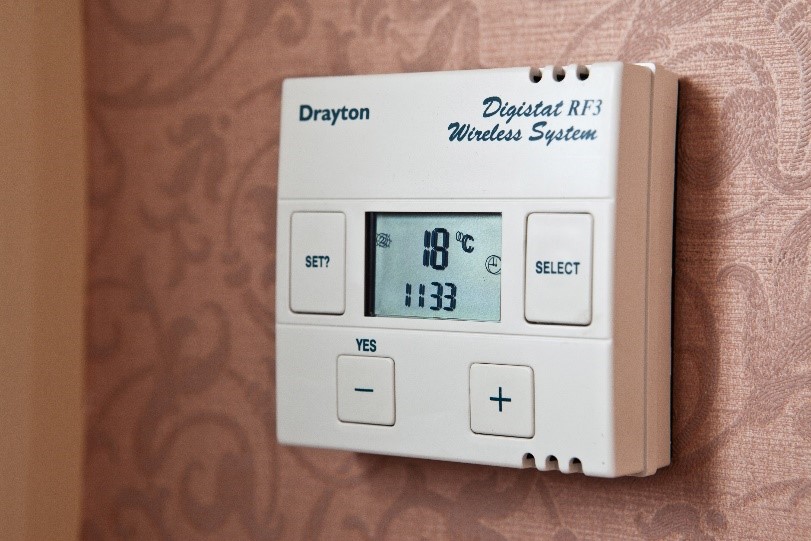Adjustable heating control. Photo copyright: The Centre for Sustainable Energy.
Modern radiators have been developed which have high thermal efficiency, can use less water and at a lower temperature, to deliver the same amount of heat to the room. By adding a thermostatically controlled valve to the radiator, those rooms which are unused can be set to a lower temperature, reducing the energy needed.
In addition, the timing of the heating/water services can be tailored to use. Modern app-controlled motorised TRVs make the setting-back of unused rooms even easier. They usually also enable weather compensation, which improved boiler efficiency during milder weather.
For most dwellings, the single largest consumer of energy is the boiler, which typically uses 60% of your energy.
Old electric boilers are commonly around 60% efficient, and some oil and solid fuel appliances which can be as low as 30-40%. Therefore, gas boilers should be replaced with renewable energy sources such as heat pumps.
Where these are not practical, or need to be supplemented, direct electric heating can be used together with PV panels - or sometimes battery storage - to offset the cost of electricity, and smooth demand peaks in the case of battery storage.
We recommend using a price comparison website to get an accurate quote and find the best deal for you.
- Renewable sources such as heat pumps are preferred over boilers. Gas boilers should be phased out.
- Carbon efficiency of an electric boiler can depend on how green your electrical supplier is. However, sometimes green tariffs do not have an impact, and it is more important from a carbon perspective to reduce peak energy demand i.e. Prioritising renewable sources before direct electric heat.
- Electrical boilers intervention can be combined with a heat exchanger.
- Cellular, rather than open plan spaces, are more efficient to heat.
- Any upgrade to the boiler system should also have the circulating pipework insulated to reduce heat loss.
Listed Building Consent is required for a new boiler installation where it will involve and extract vent and new service runs, which can affect historic fabric.
- Plumbing routes should avoid notching floor joists and should be installed parallel to them to avoid harm to historic fabric and possible structural problems.
- Principal elevations should be avoided for extract flues. Discreet and appropriate outlet styles, dimensions and colours will be of paramount importance. Specify an outlet of a discreet style, size and colour that match the surrounding wall as closely as possible to minimise its impact.
- Where practical, put the exhaust through a vertical flue in a roof that cannot be seen
- Care should be taken when planning new pipe runs to avoid damaging historic surfaces and decorations (e.g. when lifting and re-laying floorboards).
- Flues will need to be appropriately located to ensure compliance with the Building Regulations.
The government is planning to phase out new gas boilers by 2025, so we would not support the use of gas boilers and would recommend using a renewable energy source instead.
Historic England’s Energy Efficiency in Traditional Homes
Saving Energy guidance series also from Historic England

